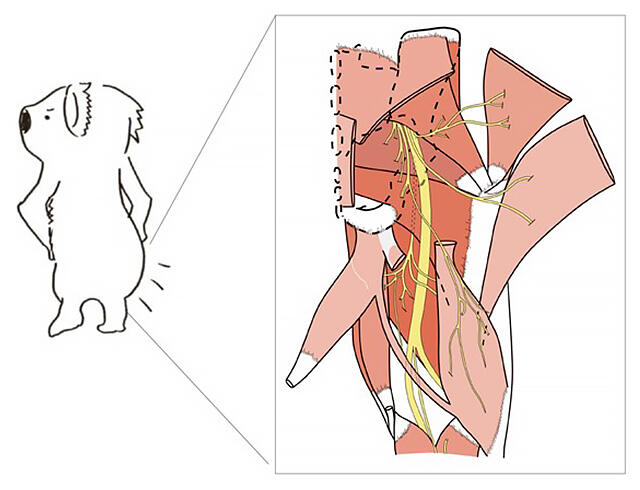A joint research group consisting of Assistant Professor Sayaka Tojima of the Hakubi Center for Advanced Research, Kyoto University, Assistant Professor Hidaka Anetai of the Faculty of Medicine, Juntendo University, Assistant Professor Saori Anetai of the Faculty of Health and Medical Care, Saitama Medical University, and their colleagues has carried out dissections (by eye) of the gluteal and posterior thigh regions of adult koala specimens belonging to the University of Adelaide in Australia, and identified the constituent muscles and the nerves innervating them, clarifying the common characteristics of arboreal primates and marsupials and the muscular formation characteristics unique to koalas. Their outcomes were published online in PLOS ONE.

Provided by Kyoto University
Mammal species include placental mammals (including humans) and marsupials, and each of these has adapted to their living environment and taken on many different forms. Although these are animals are separated into different subclasses, they have independently obtained similar forms during the evolutionary process, in a process known as convergent evolution. But are the forms obtained via these evolutionary outcomes also similar in a functional sense?
While this question is important when considering the evolution of mammals, it has been difficult to investigate for a number of reasons. One of the main reasons is that there was insufficient anatomical knowledge of marsupials. For example, different names are used for muscles thought to be equivalent to those of placental mammals, and there is considerable confusion due to differences in descriptions of the same marsupial muscles in different books, so a re-appraisal and update of people's anatomical knowledge of marsupial muscles was needed. In this study, the group selected koalas as their representative marsupial.
It is known that koala locomotion patterns include primate (placental mammal) elements and marsupial mechanistic elements. One reason for their selection was that they are a very interesting family for research on convergence evolution in mammals.With the cooperation of Senior Lecturer Jaliya Kumaratilake of the University of Adelaide and his colleagues, the group carried out dissections, by eye, of adult koala posterior and leg muscles (the gluteal and the posterior thigh regions).
During the dissection, the group identified muscles using innervation. As this method is based on the ontogenetic origin of muscles, in recent years it has been used for general anatomical descriptions of placental mammals. As a result, the group succeeded in organizing and updating their knowledge concerning koala muscle form, which had been inconsistent in previous research. On top of this, by identifying muscles based on nerve and muscle specificity, it has become possible to compare them to those of placental mammals, which had been difficult in the past. Comparing anatomical findings from marsupials to those from placental mammals serves as important knowledge when seeking an understanding of the convergent evolution of mammals.
This study has enriched anatomical knowledge, the foundation of comparative anatomy, and become the first step in furthering research on marsupials. Assistant Professor Tojima noted, "When koalas are mentioned, most people are probably able to picture them in their minds. However, what kind of muscles do they have under their skin, and how are they arranged? Most people won't be aware of this, but koala anatomy has not really been updated in the last 100 years or so. We live in a society in which the latest equipment and tools are coming out successively, and has remarkable technological innovation, but we believe that the basis for learning about living things involves properly observing and describing their forms."
Journal Information
Publication: PLOS ONE
Title: Gross anatomy of the gluteal and posterior thigh muscles in koalas based on their innervations
DOI: 10.1371/journal.pone.0261805
This article has been translated by JST with permission from The Science News Ltd.(https://sci-news.co.jp/). Unauthorized reproduction of the article and photographs is prohibited.




